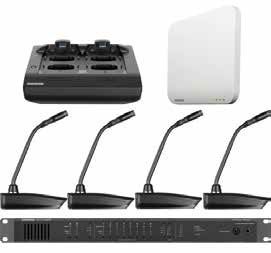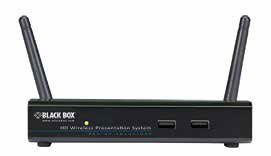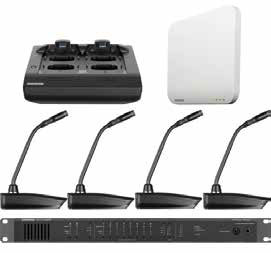From makerspaces to BYOD, more universities are acknowledging how growth-edge AV technologies are influencing not just the student experience but pedagogy as well. “Digital humanities” and “active learning” are the catchphrases du jour. Just watch the faces of freshman as a tenured professor pops in a VHS tape. Digital natives want agile, high-tech tools that prepare them for real-world careers. In turn, teachers are using GenY’s hyper-connectivity as an advantage—weaving technology into their syllabi that support active learning exchanges.
But all of this excitement doesn’t make AV integrators’ or in-house managers’ daily jobs any easier. It is a tricky balancing act: end-users want instant access, 24/7 mobility, and collaborative systems, but classroom AV should be standardized. Institutional data must remain secure. Manufacturers are stepping up their games by leveraging enterprise-grade connectivity with intuitive systems. Nowhere was this more apparent than Integrated Systems Europe 2016, which convened in Amsterdam in February. While most commercial technologies—from Dante to HDBaseT—are germane to the campus AV conversation, there were four edtech trends at the show that received serious attention: collaboration, assistive listening, creative audio, and smart projection. A drill down into each category reveals the similarities and points of distinction among notable product offerings.

Shure Microflex Advance Table Array

Revolabs FLX UC family of IP and USB conference phones.Creative Audio for Learning Spaces
When it comes to smart audio, I’ve heard it all (pun intended). But at ISE, I had the fortune to demo new products from Shure and Revolabs that really made sense from a campus perspective. The Shure Microflex Advance Table Array is a networked array microphone that captures high quality audio and provides flexibility in varying AV conferencing environments (e.g., boardrooms, huddle rooms and multipurpose spaces). The brains of the operation is the onboard IntelliMix DSP Suite, Shure’s proprietary Steerable Coverage technology, which deploys up to four discrete simultaneous coverage zones around a table and utilizes a patent-pending “toroid” pattern. This donut-shaped pattern was created to reject unwanted artifacts, specifically HVAC or projector fans. It integrates with Dante and third-party preset controllers (Crestron and AMX).
Revolabs is taking a different but similarly strategic approach to flexible conferencing audio with its FLX UC family of IP and USB conference phones. This product family delivers high quality audio for virtual meetings originating from offices, huddle rooms, and medium to large conference rooms. FLX UC 500, UC 1000, and UC 1500 combine enhanced tweeter and midwoofer elements, four integrated microphones, and audio technology such as acoustic echo cancellation, ultra-wide frequency response, and full duplex support.
Assistive Listening
Accessibility in higher education is mandated by the ADA (the Americans With Disabilities Act). But more than that, ADA-compliance sends a strong message that your school offers an inclusive culture. There were three solutions on display at ISE that could help put you on the road to ADA-ready assisting listening.
Listen Technologies’ ListenLoop makes it possible to offer a personal and discreet listening experience to anyone with a telecoil technology in his or her hearing aid or cochlear implants without additional equipment. The receiver is half the weight and size of other assistive listening devices. It is also streamlined with smarter and simpler maintenance solutions, and its upgraded battery technology saves money and battery management hassle. Integrated Neck Loop/Lanyard is also offered.
Williams Sound offers myriad wireless technologies for hearing assistance applications: induction loop, infrared (IR), FM, digital, and Wi-Fi. All of these technologies provide a direct link between a facility sound system and the listener, bypassing background noise and room acoustics.

Shipping from Media Vision is a new Assistive Listening System that provides a feature package for wireless FM listening devices at a competitive price. Shipping from Media Vision is a new Assistive Listening System that provides a feature package for wireless FM listening devices at a competitive price. While not new to assistive listening— Media Vision already delivers hard-wired and infrared solutions—the company dedicated to audio intelligibility is now expanding its application range. Operating in the FCC-designated assistive listening frequency band 72-76 MHz, using all available wideband and narrowband channels, the Media Vision assistive listening system allows up to six simultaneous transmissions. Programming, channel assignments, and settings lock, can be done either from the transmitters and receivers with clear OLED display for menu navigation, or from a user-friendly software interface. The system offers greater than 70 dB SNR to provide the user with clear audio in any situation.
BYOD Collaboration
Want to keep your organization’s students focused despite the constant presence of iPhones? Professors are using mobile devices to engage rather than distract with wireless BYOD collaboration suites. At ISE, I test-drove the wePresent’s WIPG- 1600. It hits the sweet spot between price and functionality by combining the popular features in the company’s flagship model, the WIPG-2000, with the affordability of more budget-conscious units. The WIPG-1600 can work with any operating system (e.g., iOS, Android, Windows, Mac OSX). Apple devices are capable of connection via AirPlay. Where wireless devices aren’t available, the WIPG-1600 integrates with the company’s proprietary peripheral, the SharePod, in order to connect to any device with HDMI output. The User Queue allows 64 users to connect to the wePresent gateway. It also offers enhanced security by adopting AES 128-bit encryption on mirroring data and https encryption for web browsing data. The teacher/moderator control allows a designated moderator to select and control which device in queue will be displayed on screen.
MiniVU by FSR is a new addition to the HuddleVU collaborative learning line. It offers a complete packaged solution that incorporates multi-faceted functionality in a compact footprint. MiniVU allows two to four users to share and view their laptops, tablets, and smartphone screens on a main display, delivering an ideal environment for small group study areas or a convenient break out space in large, open classrooms.
One of Crestron’s key BYOD solutions is AirMedia Presentation Gateway (AM- 100). The AM-100 isn’t new, per se, but at ISE, I got to see how well it worked within the ecosystem of Crestron’s integrated systems. The goal for the AM-100 is that anyone can walk into a room and wirelessly present PowerPoint, Excel, Word, and PDF documents, as well as photos, on the room display from their personal iOS or Android mobile device. MacBook and PC laptops can be connected seamlessly as well, making presentations from most any device fast and easy. AirMedia connects via ethernet to the LAN, and no additional software or control is necessary.

Black Box’s new wireless presentation system enables users to show content wirelessly to anyscreen, or project from any device. Planning for improvisation, that’s the key, says Dan Vorhes, Black Box’s director of product marketing, conference rooms and classroom. “The most effective types of collaboration are those that happen spontaneously as issues arise,” Vorhes said. “Instead of scheduling a meeting and a room and support hardware, these spaces are ready to be used at a moment’s notice.” To that end, the Black Box wireless presentation system enables users to show content wirelessly to any screen, or project from any device.
The ConX Wall by InFocus was created to allow users to display and interact with videoconferencing participants in full resolution, as well as conduct video calls with multiple participants from all types of SIP of H.323 endpoints. BYOD users can also wirelessly cast information to the ConX wall from their mobile device or laptop (Android, Windows, iOS, etc).

Kramer VIA Campus In addition to enabling wireless connections with remote students via embedded thirdparty video conferencing and office apps, hardware like Kramer’s VIA Campus offers collaboration with up to six user screens on one main display, or up to 12 screens on two displays. From any laptop or mobile device, students and teachers can view the main display, edit documents together in real time, share any size file, or turn the main display into a digital whiteboard.
Smarter Projection
Any tech manager can testify that classroom projector problems are the most frequent sources of help desk tickets. Projectors are lauded by some faulty and ignored by others. Here are three solutions for projection systems that are bright, flexible, and easy to use.
The Da-Lite Da-Plex Semi-Rigid is designed for applications that require rigid rear projection but cannot accommodate a large crate. It can be used with eight standard coating options formulated to fit your application requirements. Imagine an acrylic, lightweight rear projection screen that ships in a roll. Coatings are permanently bonded to the substrate and cannot peel off. The product is customizable in size, coating, and curve radius options.
One of the most attractive features about the Draper Optically Seamless TecVision is invisible—literally. The fused substrate is not visible, even when the screen is not under projection. There is also a reliability advantage: the fused substrate is stronger than traditional “tear” seams, according to the company. You can customize it, too. If a TecVision formulation doesn’t exactly meet your classroom’s need, the Draper team will work to tune in a new configuration.
Because projection screens are all that useful without sources of illumination, take a look at the new Epson EB-L25000U, a 25,000-lumen laser-light source projector, and the EB-L1000U series. The EB-L1500U is a 12,000-lumen WUXGA 3LCD laser projector. The EB-L25000U is native UWXGA and uses both inorganic LCD panels as well as an inorganic phosphor wheel to produce color-accurate color. Inputs include HDMI, HDBaseT, VGA (for all of the legacy equipment in colleges), and 3G-SDI. At ISE, Epson also demonstrated its lamp-based range of corporate and higher education installation projectors, the EB-G7000 suite.
Margot Douaihy is the editorial director of AV Technology, EDUwire, and Tech Manager Today.











